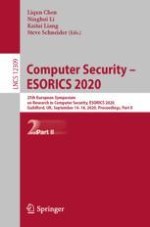The two volume set, LNCS 12308 + 12309, constitutes the proceedings of the 25th European Symposium on Research in Computer Security, ESORICS 2020, which was held in September 2020. The conference was planned to take place in Guildford, UK. Due to the COVID-19 pandemic, the conference changed to an online format.
The total of 72 full papers included in these proceedings was carefully reviewed and selected from 366 submissions. The papers were organized in topical sections named: database and Web security; system security; network security; software security; machine learning security; privacy; formal modelling; applied cryptography; analyzing attacks; post-quantum cryptogrphy; security analysis; and blockchain.
